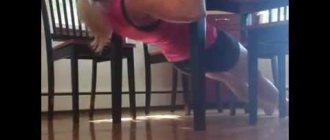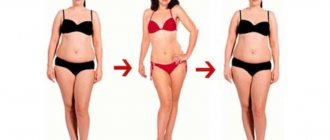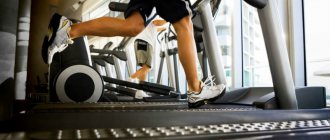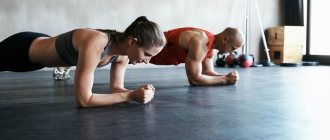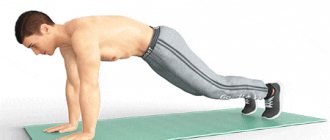The problem of properly combining cardio training with strength training is more relevant than ever in our time of a healthy lifestyle. Many people not only begin to want a toned, slightly pumped up , but are already seriously thinking about increasing endurance , functional abilities of the body, while maximizing the preservation of muscle mass and strength.
Therefore, the time has come to reveal all the secrets and tricks that will help answer the question of how to combine cardio with strength training.
But before answering the question, you need to decide what these two types of training are, which are so popular among many athletes in different sports.
How to determine the type of activity
First, you need to understand which workouts are cardio and which are strength, and what are their main differences from each other.
The first includes aerobic exercise - that is, low-intensity exercise in which the body draws energy from the oxidation products of fats and glucose. Such exercises strengthen the cardiovascular system, normalize blood pressure, improve blood flow and increase the overall endurance of the body, and also, if prolonged enough, contribute to the burning of fat deposits. Cardio includes:
- walking at a moderate or fast pace;
- run;
- cycling or using an exercise bike;
- dancing;
- aerobics;
- swimming;
- jumping rope, etc.
The second type is anaerobic exercise - one in which the body takes energy from glycogen stores, which are stored in the muscles. Such workouts are much more intense, they are aimed at increasing muscle mass, strengthening the muscle corset, creating a beautiful body contour, and accelerating metabolism. This type includes:
- any strength training with or without additional weights (push-ups, squats, lifting barbells, working with dumbbells or kettlebells);
- exercises on sports equipment.
How to alternate classes correctly
As we've already seen, cardio and strength training have different goals. The choice between these directions and the sequence of their implementation depends on your needs - that is, on whether you plan to lose weight or, on the contrary, gain weight.
- If you need to quickly lose weight and get rid of fat deposits in problem areas, it is better to do cardio after strength training.
- If you need to build muscle, “get lean” and get a beautiful definition, then it’s better to start your workout with any kind of cardio, and continue with training on exercise machines.
- If both goals are relevant to you, then these directions can be alternated - for example, on one day you start your workout with cardio, and on another day you finish with it.
Of course, there is always the classic option - to spread different activities on different days of the week. For example, you can devote several days a week to strength training, and do cardio in between these days. However, this approach is very time-consuming and requires almost daily visits to the gym, so it is not suitable for everyone.
Why alternate between cardio and strength training?
During strength training, the body actively uses stored carbohydrates (glycogen), and when they come to an end, it begins to take energy from its own fat deposits. But for this to happen, the training must be really intense and very long - that is, it will be quite difficult to sustain it. This is why many people do cardio after strength training - in this combination it has a similar fat-burning effect, but at the same time requires less preparation and is much easier to tolerate by the body.
However, you need to be careful when combining cardio with strength training: it is important to distribute the load correctly in order to avoid overexertion and not harm your body. The fact is that during intense strength training, the body spends a lot of energy, and too active or long cardio after it can completely exhaust it - especially if your body is not yet accustomed to such loads. Therefore, it is better to choose the duration and type of classes together with a fitness instructor.
Five of the Best Kettlebell Abdominal Exercises
Bodyweight exercises are great for building core abdominal strength. But if you want to get rock-hard abs with clearly defined six-pack abs, then you need to add weights to your workout. One effective way is weights.
We have already talked about the most effective abdominal exercises and want to expand the list with movements with additional weight.
“I use kettlebells because they are versatile. They allow you to perform both basic exercises and exercises for all muscle groups, they are suitable for both beginners and professionals, they can be used both in the gym and at home,” explains Ashton Turner, co-founder of a fitness club in London, strength-building specialist. “Exercising on one side disrupts balance by forcing the body to use more muscle to stay in place. Any movement behind the head, such as the Windmill, also requires core engagement in addition to balance.”
How to perform
Do three sets of ten reps, resting 45 seconds between sets, 90 between exercises. To increase the load, add one repetition per set to each workout until you reach 15. Then move on to heavier weights, while starting again with ten repetitions.
Why does it work
These exercises help you develop your anti-rotation abilities, which helps you stand stronger on your feet. Also, this training program will allow you to achieve rock-hard abs and effectively work out your oblique abdominal muscles and lower back.
Kettlebell bench press
Lie on the floor, holding a weight in each hand at chest level. Straighten one arm and push the kettlebell upward, lifting your shoulder off the floor and twisting your torso. Having lowered one arm, straighten the other using the same principle.
Tip: “By lying on the floor, you increase core stability, thereby reducing the risk of injury,” explains Turner. “I encourage my clients to “slam” their lower back into the floor. This helps prevent arching in the lower back and disabling of the abdominal muscles.”
Mill
Starting position: standing straight, holding the weight in an outstretched arm above your head, feet wider than shoulder-width apart. The weight distribution should be biased towards the hand that holds the weight. While looking at the weight, lower your body down until your other hand touches the floor.
Tip: The Windmill exercise looks intimidating, but it's worth doing for core strength and shoulder stability. This exercise is also a great stretch for the hamstrings.”
Lateral press
Starting position: kettlebell at shoulder level. Tighten your core and lower your body to the side while straightening your arm. Try to keep the kettlebell as still as possible, instead move your body. Having reached the bottom point, return to the starting position.
Tip: “A great exercise for the obliques because you need to maintain balance while pressing the kettlebell away from your core. The lower you go, the greater the intensity of the exercise and the center of gravity shifts.”
Curl Press
Holding two weights above your head, sit on the floor with your knees bent. Slowly lower yourself to the floor, moving the weights toward your chest. Tighten your abdominal muscles to rise to the starting position and push your arms up.
Advice: “While sitting straight, tighten your pelvis, and when you lower yourself, twist your back, trying to touch the floor with each vertebra in turn. The slower you move, the harder your abdominal muscles work.”
Moving the weights in the plank
Stand in a plank position with your arms straight, your body in a straight line from the top of your head to your heels, and place a kettlebell on your right side. Move your left arm under your body, grab the kettlebell and move it to your left side. Switch hands and repeat the movement.
Advice: “A good way to diversify the bar. The further away from your body you place the kettlebell, the more difficult the exercise becomes. To make the exercise even more challenging, you can lift the weight slightly off the floor.”
How long should the lesson last?
If you are going to combine these two areas in one workout, it is important to correctly calculate the time that will be spent on each of them. A standard strength workout can last anywhere from an hour to an hour and a half, so after that it will be quite difficult to endure another hour on the treadmill or elliptical. Therefore, in this case, you can limit yourself to thirty minutes of classic cardio at a moderate pace - not too fast and not too slow. This will allow your body to burn off any remaining calories, provide your body with the right level of aerobic exercise, and prevent you from becoming overtired by training too hard.
Another option is to break the cardio session into two parts that will “surround” the strength training. Before training, you can spend 10 to 15 minutes on a treadmill, exercise bike or elliptical machine - this will help your body warm up and tone up. After finishing strength training, you can return to the treadmill and exercise on it for twenty to thirty minutes to activate fat burning processes. With this approach, you will achieve several goals at once - you will train your muscles well, increase your calorie expenditure (which, by the way, will increase for several more hours after training) and you will get rid of fat deposits faster.
In any case, you need to remember that too short cardio will not have the desired effect - doing less than 20-30 minutes is useless, since during this time the body simply does not have time to switch to fat burning mode. Therefore, if you understand that you cannot work out well on the exercise machines one day and then walk on the path for another half hour, then it would be better to spread these classes over different days.
A set of exercises with two kettlebells for double results
Once you've mastered the beginner exercises and learned how to properly perform basic kettlebell exercises such as swings, presses, and cleans, you can move on to more advanced exercises. “Using two kettlebells is an advanced level of challenge because the exercise requires a strong sense of balance and muscle control,” explains London-based Evolve 353 trainer Ashton Turner. “Besides, two 16-kilogram weights seem lighter than one 32-kilogram weight.”
How to perform
Do three sets of ten repetitions, rest for 45 seconds between sets, and 90 between exercises. The second exercise involves alternately pressing the kettlebell upwards for each repetition. To increase the load, add one rep per set to each workout until you reach 15. Then move to heavier kettlebells, starting again with ten reps.
Why does it work
By using two weights instead of one, you are not breaking any rules. It doesn't matter whether you use one kettlebell or two, the load increases the same. The main thing is to make sure that you perform the exercise equally with both hands, otherwise you risk serious injury to the shoulder joint.
Swings with two kettlebells
Swing the kettlebell between your legs until you are in a neutral position (this activates your glutes). Try to keep your wrists as close to your hips as possible. At the top, tighten your gluteal muscles to reduce the load on your lower back.
Tip: “Place your feet a little wider than when performing the same exercise, but with one kettlebell. This will give you enough room for both kettlebells, and you'll be able to target your hips, glutes, and hamstrings more effectively."
Kettlebell press
Stand upright in a kettlebell-on-chest position, then perform a deep squat. Alternately perform the kettlebell press from behind your head, looking in the direction of movement of the projectile.
Tip: “Great test for the hips and thoracic spine, as well as shoulder stability.”
Snatch with two kettlebells
Swing the weights between your legs while pushing your hips forward. When they are just below chest height, bring your elbows back and lift your arms under and around the weights, using the resulting momentum to bring the weights straight above your head.
Tip: “Try to avoid placing your hands under the weights and do not perform the press as a separate movement. The exercise should be performed in one smooth movement. Two kettlebells greatly increase the difficulty and effectiveness of the exercise because you need to perform the same motion with both shoulder joints.”
Push with two kettlebells
Swing the weights between your legs while pushing your hips forward. Once they reach abdominal height, extend your elbows back and lift your arms under and around the weights to get into a kettlebell-on-chest position, then lower them between your legs and repeat the movement.
Tip: “Make sure not to move the weights too far away from your body as this will put more strain on your back muscles.”
Double overhead press
Get into a kettlebell chest position, holding the weights at shoulder height with your elbows tucked to your side for extra support. Push the weights straight up overhead, using the most efficient path to reduce stress on the shoulder joint.
Tip: “Make sure both elbows are directly under the weight during the push and that the weight is directly above your shoulders as you complete the rep.”
Source: https://www.coachmag.co.uk/kettlebell-workouts/5764/5-kettlebell-workouts-for-strength-cardio-and-fat-loss
How to exercise correctly
When playing any sport, you need to take certain precautions so as not to harm your body in any way. Both cardio and strength training have their limitations.
- The most important thing when doing cardio is to maintain the required heart rate. If it is too low, the exercise will be ineffective, and the desired fat-burning effect will be quite difficult to achieve. If the pulse is too high, it will create too much stress on the cardiovascular system. Your ideal heart rate can be calculated using the approximate formula “170 minus your age” - the result will be an approximate figure indicating the maximum heart rate limit, beyond which it is better not to go.
- For strength training, it is important to correctly calculate the load and weights you use. The situation here is almost the same - too little weight or insufficient repetitions will not give any result, and too much load can cause injuries, micro-tears in the muscles and other problems. Therefore, before starting any training, be sure to consult with the instructor.
Statodynamic training
Statodynamics is performing exercises in partial amplitude, without relaxing the muscle. This approach allows you to induce certain physiological and biochemical processes in the body that stimulate protein synthesis. This type of training includes callanetics.
| Callanetics is a set of 29 static exercises based on yoga asanas. |
During these exercises, all muscles are used simultaneously and hormones are released, which leads to a high healing effect.
In the article about the theory of local fat burning, we have already considered the mechanism of action of static-dynamic training, the main advantage of which is the absence of shock load on the musculoskeletal system and, accordingly, safety for almost all participants.
Cardio programs at FitCurves fitness clubs
Fitness experts from the international network of FitCurves clubs have developed a set of training programs that combine elements of cardio training and classic strength training. The program was created taking into account the female anatomy and characteristics of the female body and is aimed at healthy weight loss, development of flexibility, endurance and the creation of a slender, toned body.
30-minute workouts using the Fitkervs system include a warm-up, a set of strength exercises on unique hydraulic exercise machines, interspersed with rest at special recovery stations, as well as intense cardio, which allows you to burn calories more effectively and get rid of excess weight. The right combination of cardio training with exercise equipment helps to get the maximum fat-burning effect even from a short half-hour session.
FitCurves fitness rooms also offer other types of cardio training, for example, the modern dance style “Live by Dancing.” Active dancing to fiery tunes is more reminiscent of a fun party than a classic sports training, so they not only help burn calories, but also perfectly lift your spirits, energizing you for the whole day.




